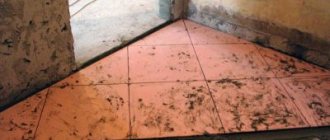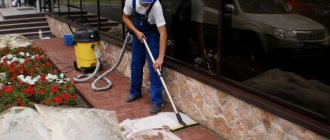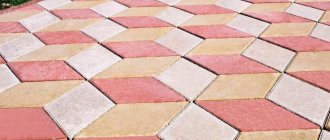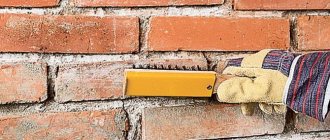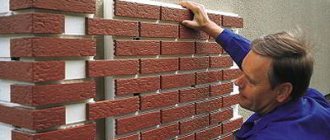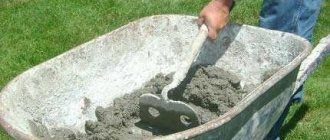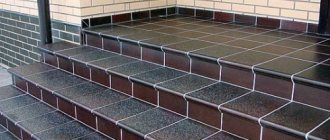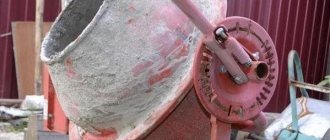During operation, figured paving elements are exposed to external factors, stains, fungus, and moss appear on them. However, some contaminants, for example, efflorescence, may occur on shaped paving elements that have not yet been laid.
Therefore, information on how to clean paving slabs from cement and other contaminants, and methods for treating the FEM surface to prevent such exterior defects is relevant for every owner of a suburban area.
Classification of contaminants and cleaning methods
Unlike common areas paved with paving slabs, garden paths, recreation areas and parking areas are less susceptible to contamination. However, here too, FEM elements become unusable or lose their artistic value due to the following contamination:
- dust/dirt – there is no protection against the spread, but can be easily eliminated;
- concrete/mortar – if construction or repair work is carried out after paving;
- efflorescence – violations of manufacturing, installation or operation technology;
Efflorescence on the tiles.
In recreation areas, it is additionally necessary to clean the sidewalk surfaces from chewing gum.
The main cleaning methods are:
- dry - with a brush or broom;
- wet - without pressure or a jet under pressure;
Mechanical cleaning of tiles.
Important! Pressurized water is used to clean and rinse off reagents at the end of work. Therefore, it is necessary to periodically restore the level of filling of the joints with sand if the inert material was accidentally removed from there.
Cleaning tiles from cement (plaque and mortar)
Cement and products based on it are especially dangerous for shaped paving elements made by vibration compaction:
- the surface of the tile is rough, which increases adhesion;
- the roughness is the main value of the coating, and when grinding with an abrasive, the structure of the concrete and the pebbles in its composition are revealed;
- It is much easier to remove cement from vibrocast tiles.
There are several main reasons for cement embedded in the front surface:
- Portland cement was moved in buckets along the paved surface or dust flew from bags;
- the binder was stored in an area with decorative covering;
- the seams of the tiles were rubbed with a grout, but the mixture was “forgotten” and the surface was washed with water immediately after completing this operation;
- façade work was being carried out, and slaps of mortar fell on the sidewalk surface.
Sedged cement on paving slabs dramatically reduces the aesthetics of the exterior.
Depending on how much time has passed after laying, or contact of cement with the rough surface of the paving lining, the following products can help:
- Tsemnot is a budget option, suitable for recently spilled cement;
- Barracuda - the solution is applied repeatedly, after each application the tiles are washed with a pressure jet from the compressor;
Cleaning FEM from cement.
A more complex option is the sandblasting technique. The disadvantage of this method is that the thickness of the tiles decreases, which negatively affects the overall service life of the coating.
Drops and cakes of the solution are first cleaned from the paving slabs with a chisel, abrasive disc or metal brush. After which cleaning is carried out using the above methods.
Efflorescence
In contrast to brickwork, where the culprit is the mortar under the ceramics, efflorescence on paving slabs appears due to additives in the cement or impurities of the very structural material from which the tiles are made.
Reasons for education
Efflorescence owes its occurrence to several reasons:
- violation of technology - in addition to cement, sand or screenings, I add modifiers to the molding mixture to increase ductility, strength, water resistance, improve other characteristics, or cement with additives;
- precipitation - with a slight slope or in the absence of storm drainage elements during heavy rain, the water does not have time to be drained from the sidewalk surface, it stagnates, and the impurities contained in it cause a white coating.
Efflorescence on the surface of the FEM may occur even before installation.
Mostly the efflorescence on the front side of paving slabs contains chemical compounds:
- metal sulfates and chlorides;
- carbonates and nitrates;
- any other mineral salts;
- compounds of iron, silicon, aluminum and magnesium;
- emissions from nearby chemical plants.
The owner of a country property can bring the wheels of his car into the parking lot with chemicals that road services use to combat ice. Some of them weather naturally, others do not dissolve in water, have high adhesion to the base, and penetrate several mm into the concrete structure.
Elimination methods
Don't wait for the efflorescence to disappear on its own. You can prevent their occurrence with silicone water repellents, but before doing this, the tiles must be cleaned of dust and at least dried by the sun. The procedure allows you to forget about efflorescence for 3–4 years, depending on the intensity of pedestrian traffic.
You can remove salt deposits that spoil the design of garden paths in the following ways:
- acids available in the house - acetic, orthophosphoric or citric, approximate dosage is a liter of solution mixed in a bucket of water;
- special means – most often based on hydrochloric acid, according to the manufacturer’s instructions;
- biodegradable detergents are the best option for paving slabs and brick facades; the products do not contain phosphates, fluorine and chlorine, and do not cause allergies or toxic reactions.
Biodegradable preparations are usually dissolved in a ratio of 1:10; after application, concrete surfaces receive the effect of a wet surface, emphasizing the texture of even unpainted paving slabs. The salt deposit is removed entirely, the surface increases moisture resistance without additional treatment.
Dark spots
In certain areas of the paving area, dark spots appear on the paving slabs, which are not considered pollution, but can reduce the aesthetics of the decorative coating.
Reasons for appearance
Unlike other defects in FEM elements, the owner cannot determine the reasons for their occurrence. No liquids were spilled in these areas, and no construction work or equipment repairs were carried out.
The cause is usually capillary suction of soil water or excess saturation with rainwater:
- concrete dries unevenly;
- the side sections of the tile are blown by the wind and become lighter;
- The central part of the FEM elements retains moisture longer, which is why it looks darker.
Dark spots on the paving stones.
This visual effect is also often observed in freshly made tiles stored in conditions of high humidity, for example, covered with polyethylene.
Elimination methods
To remove dark spots and prevent them from appearing in the future, significant effort will be required:
- to eliminate capillary suction of soil water by concrete, it is necessary to make a horizontal cutoff from a layer of crushed stone, which, unlike sand, prevents the liquid from rising upward;
- Another way is to quickly remove rain moisture from paving slabs, for which its surface is treated with a water repellent or special compounds that increase the water resistance of the structural material and at the same time give it shine and a metallic effect;
In the first case, you will have to dismantle the paving surface and replace the layer of sand under the contact layer on which the paving was made with crushed stone. This is complicated by the fact that the paving slabs could have been laid on a concrete compound (CPS mixture), in which the cement has already undergone the hydration process. Therefore, you will have to completely dispose of the garnet and lay the tiles on screenings or coarse sand with high drainage properties.
Oily stains
Most often, greasy stains are found near fireplaces and in rest areas from barbecue and ice cream, respectively. It is not always possible to wash them off with soapy water and detergents, so special preparations are used.
Causes
In addition to careless handling of food and prepared meals, greasy stains occur when carrying bags or transferring these substances to the shoes of residents. Pets also cause such pollution.
Grease stains on paving slabs.
How to delete
It is easier to remove a mark from a hard greasy piece that has fallen on a tile than from a puddle of vegetable oil. Folk remedies for greasy stains on concrete are traditionally considered:
- soap-gypsum slurry - proportions ½ cup of gypsum, a pinch of washing powder or Fairy gel, applied by hand or with a spoon, peeled off after hardening;
- soda – this substance should be poured over the stain, wait or stir on the surface, and remove with a stream of water;
In difficult cases, concentrated chemicals should be used. For example, HG cleaner is applied to the surface, which is wetted when drying for an additional 5 minutes. After that, just rinse the tiles with water.
Determining the cleaning method
The reason for contamination of the tile covering is its porous structure. Dust, dirt, organic and chemical liquids easily penetrate into microscopic holes. Partially retained in the pores, these substances are not easily removed. Depending on the nature of the contamination, the following methods of cleaning paved surfaces are distinguished:
- Dry. This means regular sweeping with a broom or soft-bristled broom. Such actions prevent the formation of dirt and help cleanse micropores.
- Wet. Problem areas are washed with a stream of clean water under high pressure. In the presence of fatty deposits, household and special detergents are used.
- Chemical. This implies the use of potent drugs based on alkali, acid and solvents. The principle of operation of these compositions is based on the destruction of the molecular structure of contaminants. Chemicals are effective for cleaning areas contaminated with fuels, lubricants and rubber marks.
- Mechanical. Foreign deposits are removed from the paving stones using scrapers, sandpaper or grinding machines. Then the treated areas are polished and primed.
- Thermal. The treatment is carried out with superheated steam, which softens and blows away organic matter, motor fuel and engine oil from the surface. In some cases, an open flame is used, turning the dirt into ash.
- Cryogenic. As a result of exposure to cold, many substances become brittle. After strong cooling, they crumble into small fragments that are easily removed.
In all cases, it is recommended to replace the sand in the seams between the fragments. Over time, the filler absorbs moisture and substances harmful to the tile, destroying it from the inside of the masonry.
How to remove oil from paving stones
To remove minor contaminants, the surface of the paving stones is washed with pre-treatment with caustic soda and sand. After removing a stain on concrete paving stones, it is recommended to fill the remaining stained area with cement. But this technology is effective in eliminating fresh stains.
It is possible to prepare a solution for washing off oil with the addition of turpentine and ammonia. Oil stains are sprinkled with talcum powder or starch, but for large-scale cleaning of paving stones such costs are not economically viable.
The mechanical method of removing oil involves treating contaminated paving stones with a grinding wheel or a drill attachment. Sandblasting is also used for cleaning, which can damage the surface of the paving stones or disrupt the density of individual stones.
Modern technologies determine how to remove oil from paving stones by selecting a special chemical that breaks down viscous machine oil at the molecular level.
Removing salt deposits
Salt deposits occur on paving stones due to a violation of the solution preparation technology and due to infection of the material by fungus. In the first case, no plasticizer was added to the concrete, the heavy filler sank down, and the salt-saturated water remained at the top. The fungus saturates the stones with moisture, which causes a white coating to form when they dry out. You can remove it in the following ways:
- Moisten the surface of the stone with a 30% solution of any acid. After 3-4 hours, rinse the surface with clean water.
- Treat the paving stones with a carbonate-based product. Soaking should be carried out for 5-6 hours, after which the stones should be rinsed with water.
- Apply a chlorine-containing product to the problem area. Rub it with a stiff brush. Chlorine destroys fungus and dissolves salts.
- Use one of the factory-made anti-efflorescence products. You must act in accordance with the instructions on the packaging.
In all cases, after processing, the stones must be thoroughly dried and treated with a deep-penetrating hydrophobic preparation. This will prevent fungal damage to the coating in the future.
How to clean tiles from fungus and efflorescence
If, after installing the tiles, they were not coated with a special hydrophobic compound, then over time the surface will lose its waterproofness, as a result of which a whitish coating (efflorescence), moss and fungus will form on it. To remove such formations, it is best to prepare an aqueous solution of a chlorine-containing preparation. Such products as “Whiteness” for washing things or the specialized composition “NEMID BiO Repair” are suitable.
Once you have decided how to clean the paving slabs, you need to:
- Wet the surface well.
- Apply the solution to the paving stones, wait a few minutes and rinse it off with an artificial bristle brush.
- Rinse the surface with water.
- If the stains have not disappeared, make a more concentrated solution.
Important! Chlorine can damage paint, so be sure to test the solution on a “test” tile first.
If you are afraid to prepare a chlorine-containing solution yourself, then buy a ready-made efflorescence cleaner for facades. It is applied with a stiff brush, after which the product is washed off with water.
Healthy! To prevent stains from forming again and having to be washed off, after treating the tiles, coat them with a hydrophobic liquid.
Cleaning up traces of cement mortar
It is most difficult to remove hardened cement mortar from the surface, since this material is the basis of the coating. Contamination appears in the form of spots, drops and sagging. You can clean cement formations from the surface of paving stones in the following ways:
- Percussion. Used to destroy large fragments. A hammer and chisel are used. Weak blows are applied to the center of the influx. This causes the piece to split and move away from the base. It is necessary to measure the impact force so as not to damage the tile.
- By scraping. Small drops and sagging can be scraped off with a knife, spatula or other tool with a flat cutting part. The blade should be positioned at a minimum angle to the surface so that there are no scars left on it.
- By stitching. Any abrasive material based on stone or diamond chips is used. The cement is ground down by hand with sandpaper. To work over a large area, it is better to use grinders or a grinder.
- By dissolution. This approach is chosen when you need to remove stains and stains. Phosphoric acid or any other product containing this substance is poured onto them. After 30-40 minutes, the cement becomes fluid and can be easily collected with a rag. Neutralization of phosphoric acid is carried out with a solution of lime or ammonia. Table salt gives good results when removing stains. It is poured onto the dirt, which after 1-2 hours becomes loose and can be easily scraped off.
How to clean tiles from cement, white deposits, grease
To wash paving stones from grease, cement or white deposits, it is necessary to use devices and compositions to effectively clean a specific type of contamination. If means of combating some compounds are used against other substances, this may at least be ineffective, and in the worst case, it will only aggravate the situation.
To destroy dirt, mechanical and chemical cleaning methods are used.
Hand tools help remove excess from paving slabs:
- scraper;
- boaster;
- hammer;
- sandpaper;
- brush with steel wire bristles;
- chisel;
- sand;
- bit.
Large cement deposits are broken with a hammer and chisel. The remaining dirt is swept away with a wire brush and then removed with coarse sandpaper.
In cases where tools alone cannot cope, special household chemicals or folk recipes will help to clean paving slabs from cement after laying.
Before you start washing with any compositions, you need to apply the preparation to the remaining excess stone after installation. This is done to test how the pavement will react to the cleaning product. The solution may destroy the artificial stone or change its color.
The sooner you start cleaning cement, grease or salt stains that have gotten onto the tiles, the better the result you can achieve.
Removing rubber marks
A yard with tread marks on the grounds and paths looks unkempt and unkempt. Often such contamination occurs from shoe heels. In the most trafficked areas, the coating may be black. You can get rid of rubber marks in the following ways:
- Superheated steam. A steam generator is used for this. Under the influence of moisture and temperature, petrochemical products turn into a liquid state and easily come out of the pores to the surface.
- Laundering. Use hot water and a strong detergent. Scrubbing is carried out with a brush with short and hard bristles. The liquid is collected with a sponge or rag by applying, but not wiping.
- By dissolution. Rubber is dissolved with gasoline, alcohol and any construction solvent. After treatment, the surface must be degreased. This procedure is carried out with a steam generator or soap solution.
Do not use scrapers or abrasives to remove rubber stains. This material is elastic; mechanical cleaning leads to deeper penetration of rubber into the pores.
Regular paving maintenance
For regular dry cleaning of debris or dust, you can use dry brushes, sweepers or garden vacuum cleaners (such as Karcher, STIHL, etc.)
. It is strictly prohibited to use tools or mechanized cleaning equipment with a metal working part, which could damage the top layer of the pavement.
Once a month, paving slabs require wet brushing or washing
. When wet cleaning, it is recommended to direct the water stream at a shallow angle to the coating in order to minimize any risk of damage to the tile joints (if the joints are damaged, it is necessary to sprinkle them with sand).
In European practice, so-called street shampoos are used for regular cleaning of the coating.
, which are a complex of surfactants that allow you to clean the surface from dirt, traces of rubber and refresh the color of the coating. Initially, the surface of the sidewalk is moistened, then shampoo is applied, and then washed off twice. Shampoo consumption is on average 1 liter per 1 m3 of water.
Timely and proper care of laid paving slabs (cleaning, washing, filling exposed seams) helps maintain the quality and durability of the coating!
Removing paint stains
Fresh paint is removed with a spatula or rag, followed by degreasing the surface. Dried stains are removed in the following ways:
- Warm water and brush. This approach is used for water-based paints. The stains must first be soaked so that they are saturated with moisture. Then the dirt is scrubbed off with a brush and periodic replacement of water.
- By special means. Industrially produced washes cause the material to peel off from the base. The swollen fragments are scraped off with a knife or spatula.
- Solvents. Oil and acrylic paints are washed off with acetone and white spirit. Rubbing is carried out with a thick cloth soaked in a chemical reagent.
- By stitching. This approach is used for nitro paint, which is resistant to all types of household solvents. Depending on the area of the stain, its surface is erased manually or using electric tools with abrasive attachments.
- Corrosion. Concentrated acid is used for large scale stains and to remove decades-old stains that have hardened to stone. The acid is applied to the surface and left for 15-20 minutes, after which it is collected in a glass container.
Removing fungal growths and mold
Fungus and mold are the result of prolonged dampness. Wetting of the tiles occurs due to improperly designed drainage or the location of the path in a low area, where melt and rainwater collects. Biological formations not only spoil the appearance of the coating, but are also dangerous to human health. You can get rid of fungus and mold in the following ways:
- By burning. Use a blowtorch or gas torch. The material must be heated for a long time so that the high temperature destroys the spores that have penetrated deep into the pores of the coating. The resulting soot and soot are washed off with a soap solution. Products made of natural stone and cement can be subjected to heat treatment. Porcelain tiles and acrylic melt when heated.
- Freezing. Fragments affected by microorganisms are removed from the masonry, wrapped in polyethylene and loaded into the freezer for a day. After this, the plaque is scraped off. The blocks need to be washed and treated with an antiseptic.
- Disinfection. A concentrated bleach solution is used to destroy pathogens. The liquid is rubbed into the pores of the stone, which remain in this state for 30-40 minutes. After this, the product should be rinsed thoroughly with clean water.
After removing the fungus and mold, it is necessary to create conditions that prevent their occurrence in the future. To do this, the paving stones need to be treated with antiseptic agents, the sand in the path cushion must be replaced, and effective drainage must be installed.
Hard coating at an affordable price
A budget option for durable road or sidewalk pavement is concrete-polymer vibro-pressed paving stones. The cost of 1 m2 of beautiful and durable cladding is on average 40% lower than the cost of similar material made from natural stone.
Vibropressed paving stones have a 30-year warranty. According to experts, the ratio of performance characteristics and price range of the material is optimal.
Traces of concrete mortar from artificial tiles can only be removed with a metal brush; acid treatment can cause destruction of the surface layer of the tile covering.
- The operating parameters of concrete paving stones are identical to vibropressed paving slabs. The price per m2 depends on the thickness of the material and its size.
- For paving garden paths and local areas, tiles with a thickness of 30-40 mm are suitable; for creating a hard surface in a parking lot or roadway, this figure increases to 70-80 mm.
An alternative material to the vibropressed assortment is moisture- and frost-resistant facing bricks. The price per square meter of paving made of facing ceramics ranges from 900 to 1400 rubles.
The cost of the material is compensated by a rich selection of color and texture options, the possibility of combining tile decor with the most popular styles of landscape design of the site.
Sticky foods and chewing gum
Stained tiles are a common sight on outdoor cafe areas and in private gazebos. These shortcomings can be eliminated in the following ways:
- By cutting. This removes chewing gum that has hardened and mixed with dust. The material is cut under the base with a sharp stationery knife. The remaining stains are washed off with alcohol, acetone or gasoline.
- By heating. When exposed to high temperatures, chewing gum becomes liquid; it can be easily collected from the surface with a thick cloth and a short-haired brush.
- By washing off. Sticky food products (lard, oil, animal fat) can be treated with a hot solution of dishwashing detergent. It is necessary to use a stiff brush to remove dirt from the pores.
- By dissolution. Protein compounds dissolve in gasoline, kerosene, acid and alcohol. The surface is soaked, brushed and the waste solution is collected with a rag.
If the above methods do not work, then the organic matter is burned out with a blowtorch, and the carbon deposits are removed with superheated steam or soap solution.
How to clean paving slabs from greasy stains
Essentially, fat is the same as oil, so to remove this type of contaminant, you can use all the methods described above. But sometimes grease can have a minor effect on the tiles, so it can be easily removed with any dishwashing detergent labeled “Anti-grease.”
In some cases, when the fat has managed to be deeply absorbed, a more radical method can be used:
- mix 1 cup of gypsum with 10 ml of liquid soap:
- stir the solution until a paste forms;
- Apply the mixture evenly onto the stain;
- leave until completely dry;
- clean with a medium-hard bristle brush;
- rinse with water.
Cleaning from soot and soot
Soot and soot remain on paths after minor repair work, butchering of animals, and from vehicle exhaust and portable generators. It is recommended to remove black stains from paving stones in the following ways:
- Wash off with water. The path is first wetted and rubbed with laundry soap. You can use inexpensive washing powder. Then the surface is brushed and then washed with a strong stream of water.
- Treatment with household products. The product for removing carbon deposits from dishes effectively removes soot and soot. You must act in accordance with the instructions on the drug packaging.
- Bleaching. Any bleach-based solution can be used. The stains are soaked in a liquid reagent and then washed with clean water. Bleach leaves whitish stains. This defect is eliminated by grinding and then adding impregnation with a coloring pigment to the surface.
- By dissolution. Resins and petroleum products dissolve in acids, household solvents and alcohol. It is necessary to wipe off the stains with a rag soaked in the solution until they completely disappear.
If the above methods do not help, the contaminants are burned off with a gas burner. After this procedure, ashes remain, which are swept away with a broom.
Removing bitumen stains and machine oil
Bitumen on sites is a consequence of careless waterproofing work. Oil stains are formed when technical fluids leak from vehicles. You can get rid of such contaminants using the following methods:
- By cutting. The resin deposits are cut off under the base. The remaining stripes and dots are carefully scraped off. Pre-freezing with dry ice will help make the work easier, as a result of which the material loses its ductility and becomes hard.
- By stitching. It is used in cold seasons when the substance is in a solid state. To remove sagging, use a rasp, coarse sandpaper or power tools with abrasive attachments.
- By dissolution. Liquids in which tar dissolves are used (diesel fuel, acetone, white spirit). It should be remembered that the substance formed as a result of the interaction of substances begins to penetrate deeply into the pores. The problem is solved with the help of an industrial washing vacuum cleaner, which completely removes the liquid from the surface.
If these approaches do not produce results, then the contaminants are burned off with an open flame, after which the deposits are swept away and the surface is washed with a soap solution.
Cleansing and impregnating preparations
Stubborn stains on paving stone surfaces can be removed using chemical cleaning agents. Preparations are available that are created specifically for washing paving stones , able to cope even with traces of car oil and other greasy stains that do not come off the tiles after using conventional detergents. It is worth finding a cleaning agent that additionally emphasizes the structure of the surface, a preparation that will restore the natural color of the tiles or will give a deeper shade.
If we have a problem with removing moss and weeds covering the surface of a path or driveway, we use a cleaning product containing a substance that destroys them. After cleaning the paving stones, it would be a good idea to coat the surface with a special impregnation that forms a barrier against discoloration and the effects of dirt. Thanks to this impregnation, the paving stones will be more resistant to dirt and cracking during frosts. It is better to purchase care products in the form of a spray or intended for use in high-pressure washers.
If you have something to add, please be sure to leave your comment on the site
Flushing away pet feces
Animal and bird excrement penetrates deeply into the pores of the finishing material, leaving not only unsightly stains on it, but also a strong, unpleasant odor. You can combat such phenomena in the following ways:
- By splitting. This approach is used in winter to remove solid feces. Any hard and sharp object that is at hand is used - a hammer, brick, chisel, hoe, bayonet shovel. Light blows are applied to the center of the fragment until it breaks. Residues are carefully scraped off the surface.
- By scraping. Dried feces are scraped off the surface of the paving stones using the blade of a spatula, hoe or hand cultivator. The remaining viscous substance is removed with a stiff brush.
- Washing. Waste products are effectively washed with hot water, to which laundry detergent or dishwashing detergent has been added. After this, the surface is rinsed with a stream of water.
- By dissolution. Organic compounds decompose into molecules in acids. Contaminated areas are filled with acid for 20-30 minutes. The liquid is then carefully collected and disposed of. Cleaned areas are rinsed with water. In the absence of acid, you can use a solution of bleach, which has a similar effect on organic matter.
Table vinegar is used to eliminate unpleasant odors. In addition, the solution performs the function of disinfection, destroying harmful viruses and bacteria.
About safety and environment
Road surface cleaning involves the use of power tools and toxic liquids. When working with these devices and materials, you need to take care of maintaining the cleanliness of the environment, the health of yourself and those around you. Safety precautions require compliance with the following rules:
- When using chemical reagents, measures must be taken to protect the skin, eyes and respiratory organs. You should work in a gas mask and rubber gloves. People and pets are first removed to a safe distance.
- When handling flammable and flammable substances, keep a safe distance from sources of open flames and heating devices with open coils. Smoking is not allowed, as this can cause reagent vapors to explode and cause burns.
- When using soap solutions and toxic preparations, it is necessary to take measures to prevent them from entering the soil. Toxic substances can enter groundwater, causing poisoning of flora and fauna, and the death of green spaces in beds and flower beds.
- After using strong chemicals, it is necessary to use substances that neutralize them.
Before using a particular drug, you should carefully study the instructions for its use and storage.
Cleaning treatment options
Before removing unnecessary deposits and drops of mixtures from the road surface, you should find out the main ways to solve the problem. In addition, you will have to stock up on everything you need. What you will need for this:
- a set of different cleaning products (baking soda, salt, garden lime, ammonia, special cleaning agent);
- brush;
- protective suit;
- chisel and hammer;
- wire brush;
- sandpaper;
- sand;
- sealant.
The best option is when any trace of contamination on paving slabs can be eliminated immediately. If this is not possible, then all manipulations with frozen stains should be carried out with the utmost care so as not to cause even greater damage to the tiled road surface.
Mechanical method
The sequence of actions in this case comes down to repeating several basic steps. Somehow:
- Removing contaminants. There is no provision for the use of any cleaning products;
- Cleaning the surface from cement stains with a spatula or a sharp knife blade;
- Final cleansing. Take a metal brush and bring the surface to perfect condition.
If there are thin spots (up to a few millimeters thick), use typical coarse-grained sandpaper. This cleaning method is very labor-intensive. However, it is also the safest, guaranteeing the safety of the tile surface. With thicker stains they do it differently - use a chisel and hammer. However, a delicate approach is required when working with them.
So, how to clean the surface of paving stones with a hammer and chisel? If sprayed concrete cannot be removed so easily, you can use the option of tapping with a chisel on the most convex places. Light blows are applied to the central point of the tubercle. In the best case, the stain will burst and begin to move well away from the base. Another scenario is that the stain does not crack after being tapped with a chisel. Then resorting to repeated manipulation of the stain and the application of great physical effort does not make sense. Because you can overdo it, which will cause it not the concrete to burst, but the tile itself. Next, arm yourself with a wire brush and clean off the remaining cement from the paving slabs. Moreover, rubbing actions take place in all directions. Here you can try again to remove the stain with a chisel. Since stripping increases the chances of the stain coming off many times over.
After this, sanding is done with sandpaper or a grinding machine. These devices will help clear the paving stones to the level of the stone.
Anyone who has a non-rigid brush or grinder can try to eliminate cement splashes with them. You should operate the devices at a low intensity speed.
Method of chemical exposure
To give your paving slabs a fresher look, the cement can be washed off using chemicals. Trisodium phosphate, neutralizers, phosphoric acid or hydrogen chloride solution are suitable in this case.
In addition, to clean concrete that has not hardened too much, you can try using ordinary table salt. It will help get rid of cement coating. First, salt is poured onto the directly contaminated area, which has been moistened in advance. After some time, the structure of cement under the influence of salt will become more loose. Therefore, it can be easily cleaned with a stiff brush.
The next point is removing stains using special cleaning compounds. In this case, it is preferable to choose products for cleaning concrete tiles that contain phosphoric acid as one of the components. The first step is to conduct a small test of the behavior of any of the compositions on an inconspicuous piece of coating or on the remains of a tile. After all, it is not known how the reaction from the interaction of the product with the tile material will manifest itself. For example, the surface may become discolored or show signs of material corrosion.
Products such as ammonia, garden lime or baking soda can act as neutralizers for the excessive effects of phosphoric acid. In this case, use any one of the indicated means. It is highly not recommended to mix them. In addition, they never forget about the safe concentration of any of the drugs.
You can repeat the attempt to clean the stain with a special solution. In this case, the stains should begin to peel off. After allowing the acid composition to sit on the stain for a short time, take a brush and gently rub it on the desired area.
An excellent product for removing old concrete stains from tiles is the industrial product Barracuda 10k. This product contains a special synthetic acid that allows it to dissolve concrete better than other compounds. Moreover, this remedy can be used even in winter. It is expensive, but its price is justified by the effectiveness of its use. It can be diluted with water (it all depends on the degree of contamination and how old the stains are). After application to the tiles, it can be periodically wiped with a rag. Again, reasonable care should be taken when choosing the portion to apply. The effect can be so strong that it corrodes not only the cement on the tile, but also the cement that is in its composition.
Another powerful method is treating cement with hydrochloric acid (hydrogen chloride solution). For domestic use, an acid concentrate is used, adjusted in the ratio specified by the manufacturer. All manipulations for cleaning paving slabs involving hydrochloric acid are carried out exclusively in compliance with personal safety measures - wearing a protective suit, gloves, and goggles. The hydrogen chloride solution is applied to the contaminated areas and left alone until completely dry. Do not touch the acid-treated area with bare hands not protected by gloves. Since if hydrochloric acid comes into contact with unprotected skin, it is unlikely that it will be possible to cope without medical help.
After everything has been done to the surface of the paving slabs, a neutralizer is applied to it. When using it, you must strictly follow the recommendations given by the manufacturer on the packaging material. After treatment, the tiles are washed with water. Saving water is inappropriate here, since all chemicals must be thoroughly washed off the tiled surface.
Trisodium phosphate helps to cope well with the task of washing tiles. In addition, after this treatment, the tonality of the tile improves. After using the product, the paving surface is also thoroughly washed with water. This substance is strictly prohibited from being mixed with any other substance, since their reaction may ultimately be completely unexpected.
The final touch is to apply a sealing layer to the cleaned tile material. Allow the tiles or paving stones to dry thoroughly before applying the sealant.
